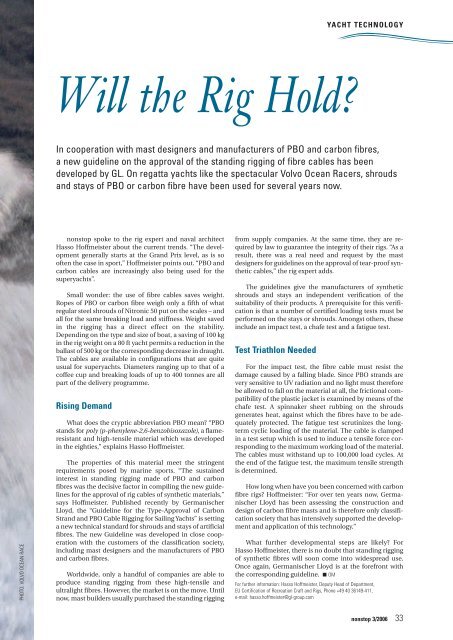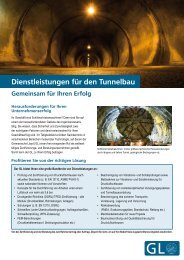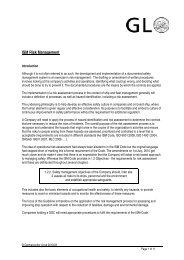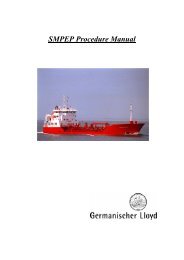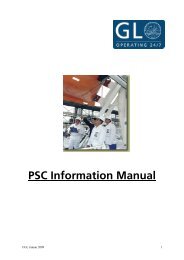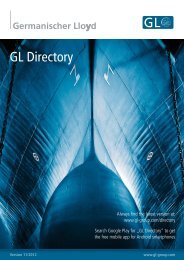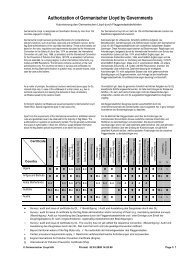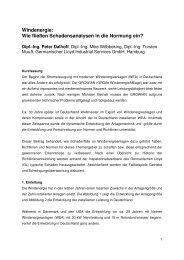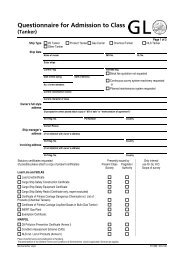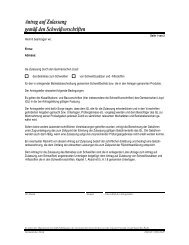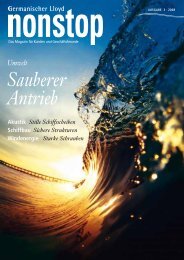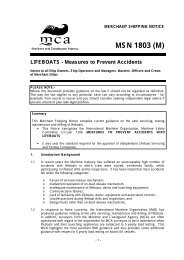Yards Moving Forward - GL Group
Yards Moving Forward - GL Group
Yards Moving Forward - GL Group
Create successful ePaper yourself
Turn your PDF publications into a flip-book with our unique Google optimized e-Paper software.
PHOTO: VOLVO OCEAN RACE<br />
Will the Rig Hold?<br />
nonstop spoke to the rig expert and naval architect<br />
Hasso Hoffmeister about the current trends. “The development<br />
generally starts at the Grand Prix level, as is so<br />
often the case in sport,” Hoffmeister points out. “PBO and<br />
carbon cables are increasingly also being used for the<br />
superyachts”.<br />
Small wonder: the use of fibre cables saves weight.<br />
Ropes of PBO or carbon fibre weigh only a fifth of what<br />
regular steel shrouds of Nitronic 50 put on the scales – and<br />
all for the same breaking load and stiffness. Weight saved<br />
in the rigging has a direct effect on the stability.<br />
Depending on the type and size of boat, a saving of 100 kg<br />
in the rig weight on a 80 ft yacht permits a reduction in the<br />
ballast of 500 kg or the corresponding decrease in draught.<br />
The cables are available in configurations that are quite<br />
usual for superyachts. Diameters ranging up to that of a<br />
coffee cup and breaking loads of up to 400 tonnes are all<br />
part of the delivery programme.<br />
Rising Demand<br />
What does the cryptic abbreviation PBO mean? “PBO<br />
stands for poly (p-phenylene-2,6-benzobisoxazole), a flameresistant<br />
and high-tensile material which was developed<br />
in the eighties,” explains Hasso Hoffmeister.<br />
The properties of this material meet the stringent<br />
requirements posed by marine sports. “The sustained<br />
interest in standing rigging made of PBO and carbon<br />
fibres was the decisive factor in compiling the new guidelines<br />
for the approval of rig cables of synthetic materials,”<br />
says Hoffmeister. Published recently by Germanischer<br />
Lloyd, the “Guideline for the Type-Approval of Carbon<br />
Strand and PBO Cable Rigging for Sailing Yachts” is setting<br />
a new technical standard for shrouds and stays of artificial<br />
fibres. The new Guideline was developed in close cooperation<br />
with the customers of the classification society,<br />
including mast designers and the manufacturers of PBO<br />
and carbon fibres.<br />
Worldwide, only a handful of companies are able to<br />
produce standing rigging from these high-tensile and<br />
ultralight fibres. However, the market is on the move. Until<br />
now, mast builders usually purchased the standing rigging<br />
YACHT TECHNOLOGY<br />
In cooperation with mast designers and manufacturers of PBO and carbon fibres,<br />
a new guideline on the approval of the standing rigging of fibre cables has been<br />
developed by <strong>GL</strong>. On regatta yachts like the spectacular Volvo Ocean Racers, shrouds<br />
and stays of PBO or carbon fibre have been used for several years now.<br />
from supply companies. At the same time, they are required<br />
by law to guarantee the integrity of their rigs. “As a<br />
result, there was a real need and request by the mast<br />
designers for guidelines on the approval of tear-proof synthetic<br />
cables,” the rig expert adds.<br />
The guidelines give the manufacturers of synthetic<br />
shrouds and stays an independent verification of the<br />
suitability of their products. A prerequisite for this verification<br />
is that a number of certified loading tests must be<br />
performed on the stays or shrouds. Amongst others, these<br />
include an impact test, a chafe test and a fatigue test.<br />
Test Triathlon Needed<br />
For the impact test, the fibre cable must resist the<br />
damage caused by a falling blade. Since PBO strands are<br />
very sensitive to UV radiation and no light must therefore<br />
be allowed to fall on the material at all, the frictional compatibility<br />
of the plastic jacket is examined by means of the<br />
chafe test. A spinnaker sheet rubbing on the shrouds<br />
generates heat, against which the fibres have to be adequately<br />
protected. The fatigue test scrutinizes the longterm<br />
cyclic loading of the material. The cable is clamped<br />
in a test setup which is used to induce a tensile force corresponding<br />
to the maximum working load of the material.<br />
The cables must withstand up to 100,000 load cycles. At<br />
the end of the fatigue test, the maximum tensile strength<br />
is determined.<br />
How long when have you been concerned with carbon<br />
fibre rigs? Hoffmeister: “For over ten years now, Germanischer<br />
Lloyd has been assessing the construction and<br />
design of carbon fibre masts and is therefore only classification<br />
society that has intensively supported the development<br />
and application of this technology.”<br />
What further developmental steps are likely? For<br />
Hasso Hoffmeister, there is no doubt that standing rigging<br />
of synthetic fibres will soon come into widespread use.<br />
Once again, Germanischer Lloyd is at the forefront with<br />
the corresponding guideline. ■ OM<br />
For further information: Hasso Hoffmeister, Deputy Head of Department,<br />
EU Certification of Recreation Craft and Rigs, Phone +49 40 36149-411,<br />
e-mail: hasso.hoffmeister@gl-group.com<br />
nonstop 3/2006 33


